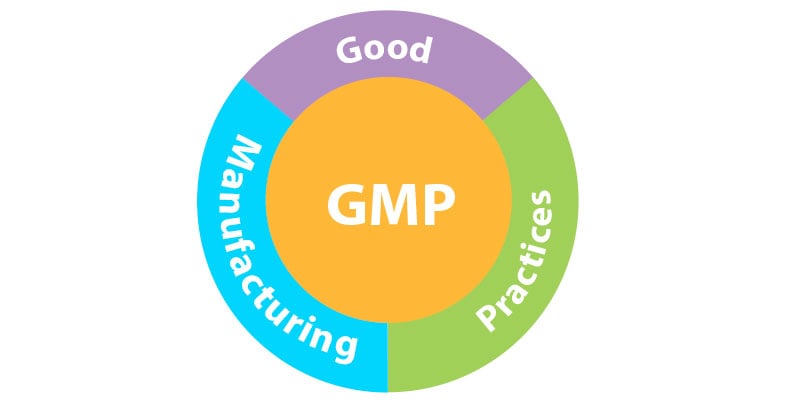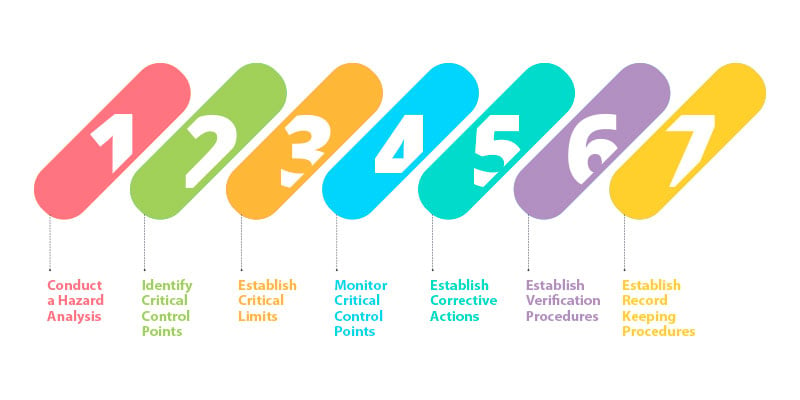Initially, the concept was developed by NASA to ensure the production, processing, and storage of safe foods suitable for space. Since the 1960s HACCP has been adopted as the de facto standard for universal food safety and quality in the global food trade. As such, it has been introduced in the relevant legislation of many countries.
Let's go over the principles of HACCP to help set up your own plan.
The seven steps of HACCP
From your research, you probably know that the HACCP guidelines are based on seven basic steps. They allow us to identify, monitor, and control hazards that could endanger food safety in all segments of the food industry.
1. Conduct a Hazard Analysis
You need to investigate your process and identify where significant hazards to food safety are likely to occur. Hazards can be biological (bacteria, fungi), chemical (toxin) or physical (metal, glass). Each hazard's relative risk needs to be evaluated and you must come up with procedures to prevent, eliminate or control the risks.
2. Identify Critical Control Points
Critical control points are steps in your process at which control measures can be implemented and hazards can be prevented, eliminated, or reduced to acceptable levels.
You consider a step a critical control point when a hazard cannot be controlled at a later stage. The number of control points depends on your individual process. It is possible to control multiple hazards with one critical control point, or necessary to use several to control one hazard.
3. Establish Critical Limits
The next step is to establish critical limits for the control points. They present a maximum or minimum level which must be adhered to. Scientific research or regulatory standards form the basis for them.
Criteria for those limits often include temperatures, pH-levels, or visual appearances. Ideally, you should use some kind of alarm system for when a critical limit is close to failing.

4. Monitor Critical Control Points
Monitoring is essential to the effectiveness of your HACCP plan. It can consist of manual or automatic measurements and observations to confirm critical limits are being met. It has to cover limits for each critical control point. It's important that the methods allow for the quick application of corrective actions.
5. Establish Corrective Actions
When a deviation at a critical control point occurs, corrective actions must be taken. Predefined procedures come into play to prevent, eliminate or reduce hazards to an acceptable level. It is imperative to act swiftly to ensure potentially hazardous food is not released.
6. Establish Verification Procedures
Periodically, you need to review and verify if all established steps in your process are operating according to the plan. This may include a review of your records, machine maintenance, or checking that measures have their intended effect. Your HACCP actions must be effective to keep your food and customers safe.
7. Establish Record Keeping Procedures
The last, but not least important, step is record-keeping - a complete documentation of your plan and procedures. It shows that you have followed the proper procedures and that the food was handled in a safe manner (regulatory compliance!).
The records help you to analyze any possible problem areas and show how well you have been doing at preventing hazards.
HACCP – a stand-alone process?
HACCP can create the impression of being a stand-alone solution for food safety. But it's just one tool, built around other food safety and quality management programs. They work together to avoid and reduce food safety hazards.
These extra programs include Good Manufacturing Practices (GMP), general sanitary practices, or personal hygiene programs. Even though they may not be considered critical, clean equipment or waste management is necessary for the effectiveness of your HACCP plan.

Quality management systems according to the globally recognized ISO 9001 standard are often used alongside HACCP. Following their guidelines, they help ensure the high quality of food products and their safety.
To make the HACCP implementation successful, commitment to the concept must start with the management. The leadership's dedication provides the necessary sense of the importance of food safety throughout the company.
This way you can show your ability to provide good food products that meet both customer and regulatory requirements. Let your business strive on safe quality products.
You might think about applying HACCP just to be compliant. But it will lead to a massive amount of paperwork and become a meaningless burden to your employees.
Digital HACCP – Escaping the paper madness
 Obviously, there are some unappealing aspects mentioned about HACCP: time-consuming, costly record keeping or stacks of papers from checklists.
Obviously, there are some unappealing aspects mentioned about HACCP: time-consuming, costly record keeping or stacks of papers from checklists.
Your employees will do a number of checks required by the HACCP plan daily. Documentation of these procedures is crucial to food safety and the efforts of your HACCP concept.
While it seems tedious, you can streamline the whole process of checklists, monitoring, and reporting with Sensire's digital HACCP solution.
We believe that HACCP compliance should be easy and not a burden to you or anyone involved in food safety.
Digital HACCP ensures that all monitoring is done in the correct way and on time. In connection with the Sensire Cloud, you have all the information concerning your records available in one place.
It is an effective digital HACCP solution for following your HACCP plan.
How to get started with HACCP
Now we have given a brief overview of what HACCP is, what seven steps are required in a HACCP plan, and how digitization can help with the implementation.
Using an effective HACCP system is not just to fulfill regulatory requirements, but to make your food business successful.
We have prepared an introductory guide with some more in-depth knowledge about getting started with HACCP and its benefits for food safety:
- How to start creating an HACCP plan?
- What are the hazards in HACCP?
- How to identify hazards and critical control points?
- What are the benefits of implementing HACCP?
- What does digital HACCP add to the mix?

